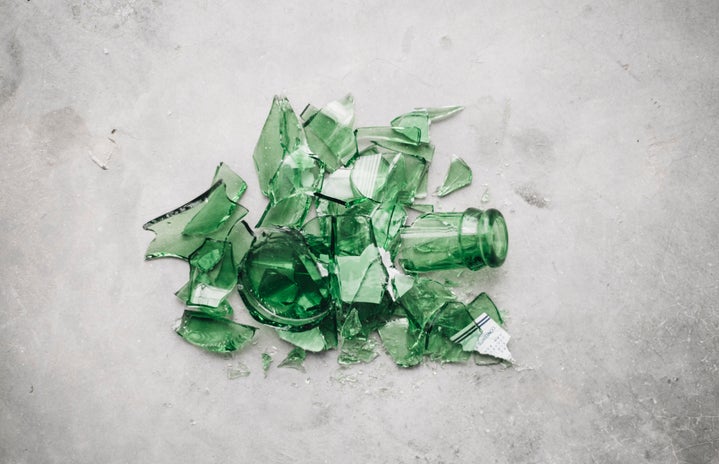When I asked my Tinder date to join me at a rage room, I expected him to swoon at the sight of me valiantly swinging a crowbar. Anyone who knows me would probably tell you I’m one of the most unathletic people they know, but I figured maybe with a crowbar in hand, I’d finally physically embody that graceful, independent woman I am in my own mind.
I hadn’t, however, anticipated the white, plastic marshmallow suits we’d be forced to wear as protective equipment.
For the uninitiated, a rage room is a space where customers can pay a fee to violently destroy items, such as glassware or electronics, without the cleanup hassle – or potential property damage – of smashing things at home.
Battle Sports, a “niche sports entertainment arena,” offers a series of packages for their rage room, ranging from a $20 BYOB – or Bring Your Own Box – to a $120 “Super SMASH” package, which includes 40 glassware items and two electronics for one to four people. My date and I opted for the “Date Night” package, with 28 items and 2 electronics; though in the end, we only received one microwave to destroy.
Jimmy Cheung, co-owner of Battle Sports and a man whose tone of voice is not unlike an excitable child, says the allure of the rage room is the ability to vent anger in a safe space.
“I like to think we’re saving lives,” says Cheung. “It’s way more legal than murder.”
When my date and I arrived, we were instantly halted by the employee at the front desk, who guided us to a wall of iPads in order to sign a waiver acknowledging the risks involved, including “injury, worsening of an existing medical condition, or death.”
Before entering the rage room, we were instructed to wear the aforementioned plastic suits, industrial gloves, a chest plate and a face shield that smelt undeniably like a Lysol wipe.
Though my date and I were originally hesitant to begin smashing the items, I have never felt more powerful than I did while swinging a sledgehammer through the window pane of a microwave to “Barbie Dreams” by Nicki Minaj. I felt like the rage room experience would be incomplete without some empowering female sass courtesy of Minaj and others like Beyoncé to get me in the mood.
After 45 minutes, 28 items of shattered glassware and a demolished microwave, I returned my weapons and disrobed. But I didn’t feel any calmer. In fact, I felt on edge.
I’m not a confrontational person. I’ve never felt enough anger to warrant physical violence. Growing up, my parents would often use the cliché phrase that I “would never hurt a fly.” Still, as someone with generalized anxiety, I expected to feel some level of stress relief. I’d had plenty of fun, but my mind certainly wasn’t at peace.
“If you truly are not an angry person, it’s unusual for you to force upon yourself an angry sentiment to be able to act in that ‘rage-y’ way,” says Perry Adler, a Montreal-based clinical psychologist.
Many professionals, including Adler, do not believe channeling anger into a rage room is as healthy as Battle Sports claims.
Anger is based on injustices, Adler says. Anger occurs when we believe something unfair has happened to us or to someone with whom we can empathize – getting cut off in traffic for example. Rechanneling these feelings of injustice in order to use a rage room may be detrimental to one’s mental health.
“The claim that rage rooms can serve as a positive outlet for anger is based on the inaccurate belief that anger builds like a pressure cooker,” continues Adler. “According to this belief, if you do not vent your anger from time to time, it will explode.”
Adler adamantly disagrees with the use of rage rooms because he feels to some, they may view the experience as a substitute for therapy – which it is not. He believes that ultimately, the frequent participation in rage rooms to vent anger will condition one to have more violent reactions to stressors in their own life. Perhaps because I myself am not a violent person and confrontation is never my first approach, the rage room experience left me rattled.
While there are no exact statistics on how many Canadians may suffer from anger-related issues, a Harvard study discovered close to eight per cent of American adolescents “display anger issues that qualify for lifetime diagnoses of intermittent explosive disorder.”
Even more disturbing, a study by the Behavioral Sciences and the Law journal found that nearly nine per cent of Americans – about 22 million people – have a history of impulsive angry behaviour and have access to a gun.
“Anger serves a purpose. If the perception of injustice is accurate, one should use the energy produced by anger to try to affect change,” Adler says. “Going into a rage room, while momentarily exhilarating and satisfying, rewards the use of destructive and violent means to respond to feelings of anger.”
He warned that repeated use of a rage room may condition one to become aggressive as a means of dealing with anger, the opposite of what psychologists encourage patients to do.
Adler went on to equate the ongoing participation in rage rooms to drug use. “There’s another way to control anger, but it too is not terribly healthy or adaptive.”
“They may attract people who don’t feel empowered in their life,” he says, of rage rooms. In a tangential connection, Adler explains that participants of fringe political groups, like the Alt-Right, may be some of the individuals to whom a rage room would appeal.
With an increasingly violent social, whether or not rage rooms provide a legitimate form of release is an important question. After all, if someone can vent their frustration in a safe and monitored space, perhaps cities like Toronto would not be reaching all-time high homicide rates.
When asked if he believed that like Adler says, violence has the possibility to create more violence, Cheung referenced a group of therapists that bring their clients to the rage room. In a safe space and under the watchful eye of their doctors, Cheung says the patients with anger management issues are encouraged to project their frustrations on the items being destroyed.
“With society, you’re often told rage and anger are terrible things and you’re told to hide or oppress them,” he says. “What these therapists are trying to tell their clients is just because you feel rage, just because you feel anger, it doesn’t mean that you’re a bad person.”
“It’s not even always about rage. It’s about having a creative outlet to release that stress,” says Karyn Elliot, the general manager at Battle Sports – and Cheung’s recent fiancée.
Elliot also explained that many fail to realize the element of physical activity involved in the rage room. The release of endorphins will trigger a sense of relief and happiness, she says.
The pair revealed that most of their clientele for their rage room, about 70 per cent Cheung estimated, were female.
Both said many “divorce parties” visit their location, where after signing the official legal documents for divorce, groups of women use the rage room. Cheung recalled a time when one woman came with her friends and a box of her ex-husband’s possessions. Before smashing each item, they would all say something mean about him.
Another time, a woman brought her cheating husband along with all of his possessions. “He just stayed in the corner and watched her destroy all his stuff,” Cheung says. “He was quiet as a mouse. When they left, he was patting the sweat off of her forehead, she thanked him and he left with his tail between his legs.”
Battle Sports also offers “Anti-Valentine’s Day” packages in February. Last year, Cheung says a young man came with a big collage of photos and notes titled, “Why I Will Always Love You,” which he destroyed.
“As I was cleaning it up, there were these little post-it notes that I found on the ground and it said ‘You always treat me like a princess,’ or ‘You always call,’” Cheung says, joking about how that was obviously no longer true.
The pair have also witnessed customers use their rage room because of work stress, for date nights and for bachelor and bachelorette parties.
Cheung noted that some of the most popular music customers choose to play in their rage room is “You Oughta Know” by Alanis Morissette, Rage Against the Machine, Metallica and “Let it Go” from Disney’s Frozen soundtrack.
Battle Sports also offers a recording of their rage room sessions for those who want to post the experience to YouTube or social media. Over half of the participants ask to take home their recording, Elliot says.
While Cheung and his fiancée boast about the benefits of their rage room, Cheung has never participated in one himself. Since he used to work in construction, Cheung says he’s had enough demolition to last him a lifetime.
“If I get upset, it’s cereal and cartoons for me, and I’m a lot better,” he says. “My fiancée has done it five times. That probably says a lot about our relationship,” Cheung jokes.
Many people travel long distances to visit Battle Sports, the only trademarked rage room in Canada, like Gabie Rudytè, a personal trainer from New York City. While visiting a friend in Toronto, she decided to try out their rage room as part of her YouTube series, “Doing things for the first time.” In it, she and her friend visit Battle Sports and try out the rage room, where Rudytè and her friend pose in a montage set to aggressive royalty free music. She even jokes to the camera about being cheated on before throwing a glass cup at the wall.
“Most of the time, I was too frightened to hit anything,” she says. “It just felt weird. I’m definitely not a violent person. I couldn’t go all out.”
Despite her hesitation, Rudytè says she and her friend still had fun.
“If you’re going through a very difficult time or have a lot of anger, it’s a very safe environment to let it all out because nothing’s going to happen. Your neighbours aren’t going to call the police,” she says.
Others, like Katie Parkes, wanted to visit Battle Sports for emotional release.
Parkes initially thought she and a friend had booked separate rage room sessions and was slightly disappointed when they realized they would be doing their session together. Parkes said the experience was still entertaining, but because she wasn’t alone, it wasn’t the cathartic experience she’d expected.
“I really wanted to use the experience to get out any anger or resentment or built up emotion that was still inside of me,” she says. After a tough year dealing with her mental health, Parkes had planned to tailor her rage room experience to herself, creating a Spotify playlist of songs, including some sadder songs which she removed when she discovered she would be participating with her friend.
“When we did it together, it became more of a fun, laughing type experience,” she says.
“When it’s closed and it’s safe and you’re doing it for the right reasons, I don’t think there’s anything wrong with it.”
“I hope people have fun,” says Cheung. “At the same time, if they went there to find a safe environment to release their anger, to release their rage, I hope they get that,” Cheung says.
“We’re not here to judge you or to pass any kind of opinion. We’re here to make sure you’re happy and safe, and you’re trying something that you’ve never done before,” says Elliot. “Everyone rages differently.”
Battle Sports offers an almost safe injection site for violent people, but whether that service is beneficial to one’s wellbeing or just merely Instagram worthy, may perhaps remain unseen.


